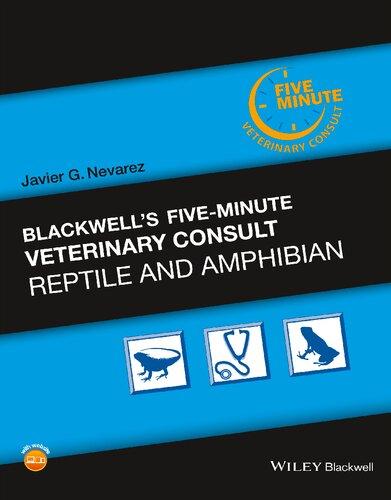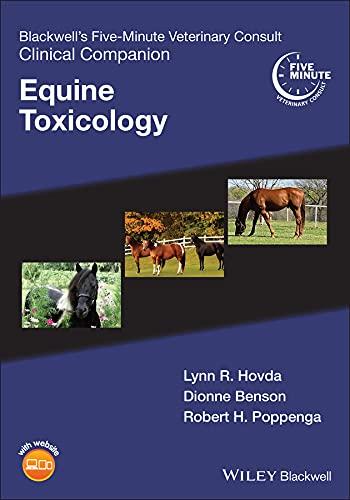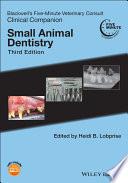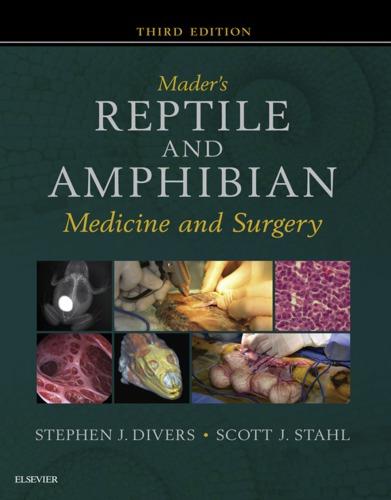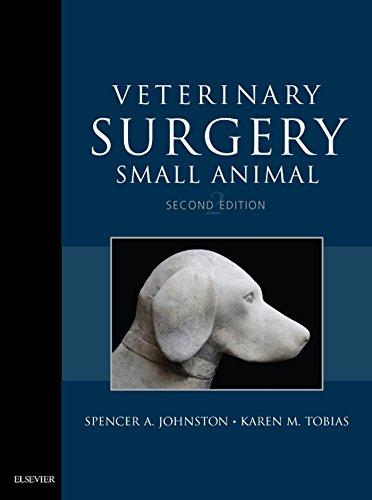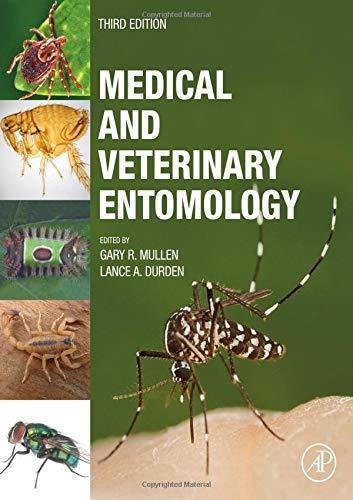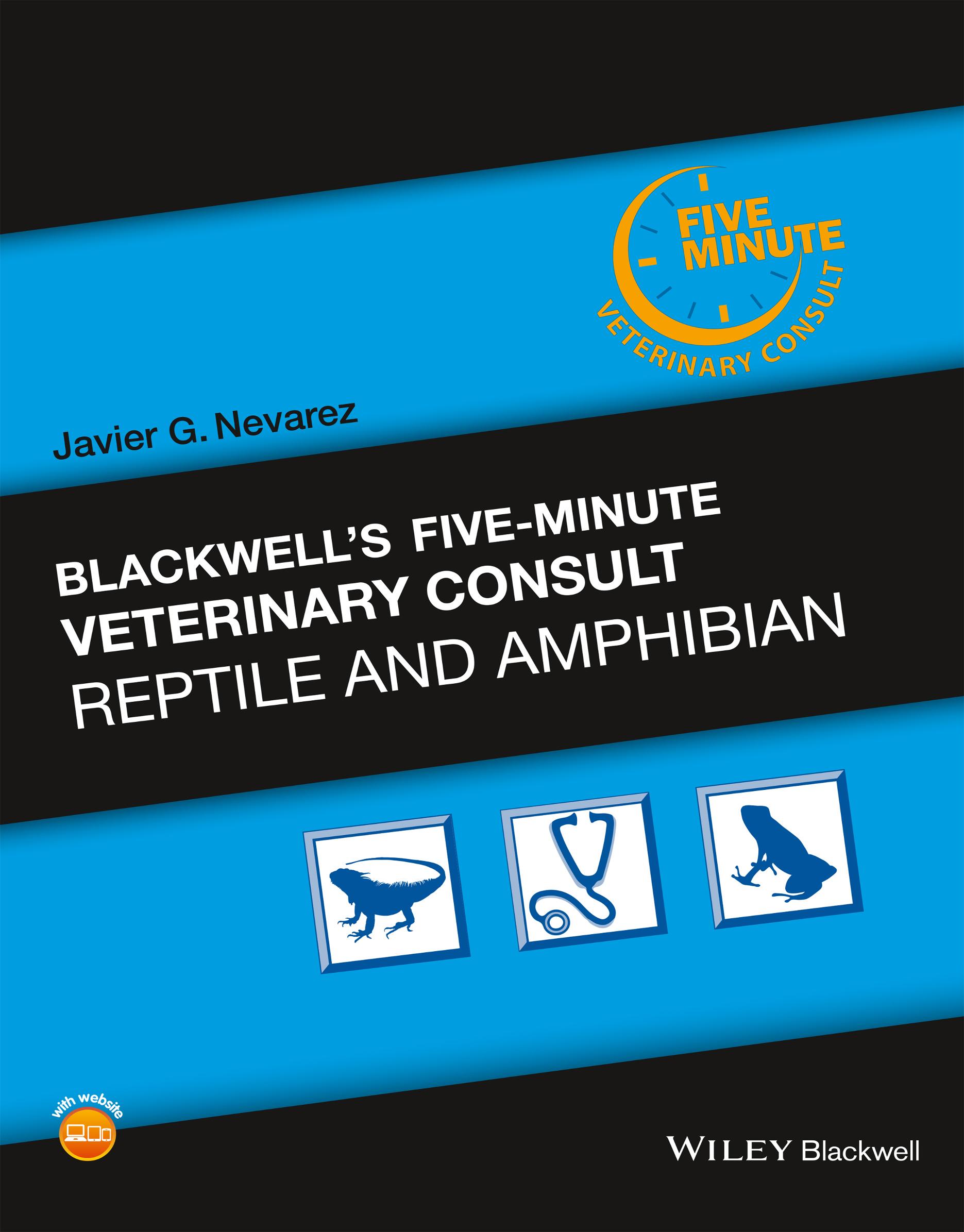Contributors
VOLUME EDITOR
JAVIER G. NEVAREZ, DVM, PHD, DACZM, DECZM (HERPETOLOGY)
Professor of Zoological Medicine
School of Veterinary Medicine‐Veterinary Clinical Sciences
Louisiana State University Baton Rouge, LA USA
CONTRIBUTORS
MADS F. BERTELSEN, DVM, DVSC, DACZM, DECZM (ZOO HEALTH MANAGEMENT)
Zoological Director
Copenhagen Zoo Frederiksberg Denmark
THOMAS H. BOYER, DVM, DABVP, REPTILE AND AMPHIBIAN PRACTICE
Pet Hospital of Peñasquitos San Diego, CA USA
ELSBURGH O. CLARKE III DVM, DACZM
Senior Staff Veterinarian
SeaWorld San Diego, CA USA
ROB L. COKE, DVM, DACZM, DABVP (REPTILE & AMPHIBIAN), CVA Director of Veterinary Care
San Antonio Zoo
Animal Health Center San Antonio, TX USA
NICOLA DI GIROLAMO, DMV, MSC (EBHC), PHD, DECZM (HERPETOLOGY) Center for Veterinary Health Sciences
Oklahoma State University Stillwater, OK USA
GRAYSON DOSS, DVM, DACZM
Clinical Assistant Professor, Zoological Medicine
School of Veterinary Medicine
University of Wisconsin‐Madison Madison, WI USA
CHRISTOPHER S. HANLEY, DVM, DACZM
Assistant Director
Department of Animal Health
Saint Louis Zoo
Saint Louis, MO USA
JOANNA HEDLEY BVM&S, DZOOMED (REPTILIAN), DECZM (HERPETOLOGY), MRCVS
Royal Veterinary College London UK
ERIC KLAPHAKE, DVM, DACZM
Associate Veterinarian
Cheyenne Mountain Zoo
Colorado Springs, CO USA
TAMARA KRUSE, DVM, MS
Assistant Director of Veterinary Care
San Antonio Zoo
Animal Health Center San Antonio, TX USA
STACEY LEONATTI WILKINSON, DVM, DABVP (REPTILE AND AMPHIBIAN)
Owner and Head Veterinarian
Avian and Exotic Animal Hospital of Georgia Pooler, GA USA; Adjunct Assistant Professor
Companion Animal North Carolina State University College of Veterinary Medicine Raleigh, NC USA
CHRISTOPH MANS, DR. MED. VET., DACZM
School of Veterinary Medicine University of Wisconsin‐Madison Madison, WI USA
RACHEL E. MARSCHANG, PD, DR. MED. VET., DECZM (HERPETOLOGY), FTÄ MIKROBIOLOGIE
Laboklin GmbH & Co. KG Bad Kissingen, Germany
ALBERT MARTÍNEZ‐SILVESTRE, DVM, MSC, PHD, DECZM (HERPETOLOGY), EBVS EUROPEAN VETERINARY SPECIALIST IN HERPETOLOGICAL MEDICINE AND SURGERY, ACRED. AVEPA (EXOTIC ANIMALS)
Scientific Director
Catalonian Reptile and Amphibian Rescue Center (CRARC)
Masquefa, Barcelona Spain
KARINA A. MATHES, DVM, DR. MED. VET., DECZM (HERPETOLOGY), EUROPEAN VETERINARY SPECIALIST IN ZOOLOGICAL MEDICINE (HERPETOLOGY), CERTIFIED SPECIALIST IN REPTILES (FACHTIERAERZTIN FUER REPTILIEN), CERTIFIED SPECIALIST IN REPTILES AND AMPHIBIANS (ZB REPTILIEN UND AMPHIBIEN)
Head of the Department of Reptiles and Amphibians
Clinic for Small Mammals, Reptiles and Birds
University of Veterinary Medicine
Hannover Hannover Germany
MARK A. MITCHELL, DVM, MS, PHD, DECZM (HERPETOLOGY)
Louisiana State University Baton Rouge, LA USA
FRANCESCO C. ORIGGI DVM, PHD, DACVM (VIROLOGY), DACVP, DECZM (HERPETOLOGY)
Vetsuisse Faculty University of Bern Bern Switzerland
JORGE ORÓS, DVM, PHD, DECZM
Veterinary Faculty
University of Las Palmas de Gran Canaria
Las Palmas Spain
JEAN A. PARÉ, DMV, DVSC, DACZM, DECZM (ZOO HEALTH MANAGEMENT)
Senior Veterinarian Zoological Health Program
Wildlife Conservation Society Bronx, New York, NY USA
SEAN M. PERRY, DVM, PHD
Associate Veterinarian Mississippi Aquarium Gulfport, MS USA
PAUL RAITI, DVM, DABVP (REPTILE AND AMPHIBIAN PRACTICE)
Beverlie Animal Hospital Mt. Vernon, New York, NY USA
DRURY R. REAVILL, DVM, DABVP (AVIAN AND REPTILE & AMPHIBIAN PRACTICE), DACVP
Zoo/Exotic Pathology Service Carmichael, CA USA
SAM RIVERA, DVM, MS, DABVP (AVIAN), DACZM, DECZM (ZOO HEALTH MANAGEMENT)
Senior Director of Animal Health Zoo Atlanta Atlanta, GA USA
T. FRANCISCUS SCHEELINGS, BVSC, MVSC, PHD, MANZCVSC (WILDLIFE HEALTH), DECZM (HERPETOLOGY) Monash University School of Biological Sciences Clayton, Victoria Australia
LIONEL SCHILLIGER, DVM, DECZM (HERPETOLOGY), DABVP (REPTILE & AMPHIBIAN PRACTICE) Clinique Vétérinaire du Village d’Auteuil Paris France
PAOLO SELLERI, DMV, PHD, SPECPACS, DECZM (HERPETOLOGY & SMALL MAMMALS)
Clinica per Animali Esotici Rome Italy
JACQUELINE SERIO, DVM
Animal Emergency and Specialty Center of Brevard Melbourne, FL USA
KURT K. SLADKY, MS, DVM, DACZM, DECZM (ZOO HEALTH MANAGEMENT & HERPETOLOGY)
Clinical Professor
Zoological Medicine/Special Species Health
Department of Surgical Sciences
School of Veterinary Medicine
University of Wisconsin‐Madison Madison, WI USA
TREVOR T. ZACHARIAH, DVM, MS, DACZM
Director of Veterinary Programs
Brevard Zoo Melbourne, FL USA
Preface
Herpetological medicine has been an important part of my professional career and has provided me with the opportunity to travel the world and broaden my horizons. These experiences have shown me that, as with many aspects of life, we are all more similar than we are different and veterinary medicine is no exception.
This book has contributions from authors working around the world, most of whom are specialists in herpetological medicine or have a keen interest in the field. This was a conscious approach when starting this project to ensure that the information contained in the text was from the most reliable sources while also not being a strictly academic approach. As a result, this book provides a combination of accepted scientific data combined with clinical and practical experience and advice on various subjects in herpetological medicine. It serves as a quick reference to learn new information or as a refresher of previously learned material in a concise manner.
The needs of our patients and the basic principles of how we approach their care are the same around the world. As you read the information, my hope is that you come to the realization that we ultimately practice one medicine in one world. I hope this book inspires you to continue to learn more about herpetological medicine and be a lifelong learner. I believe that veterinary students, practitioners, and others will find it a useful resource for navigating through cases in quick manner that fits our busy lives.
Javier G. Nevarez
Introduction to Reptile Medicine
Captive reptiles can be found in zoological institutions, the pet trade, commercial farming, universities, and laboratory animal facilities. Along with the prevalence of captive reptiles, there is a higher demand for improved welfare and veterinary care. As veterinarians, it is our duty not only to provide high‐quality medicine but also to serve as a source of reliable information and education for reptile owners and keepers. Veterinary care of reptiles must include education on proper husbandry and nutrition, two critical factors that influence the health of reptile patients. To be successful in this endeavor, we must understand the reptile market and the demographics of reptile owners and keepers. According to a 2019–2020 report by the American Pet Products Association, reptiles comprise approximately 4.5% of the pets owned by households in the United States. The Federation of British Herpetologists claims that the number of pet reptiles in the United Kingdom may surpass that of dogs and cats, but it is difficult to find supporting data for these claims across European countries. Nonetheless, it is well known that the reptile trade is strong and thriving in Europe as well as in the United States. Of interest is the age distribution of reptile owners in the United States. Fifty‐three percent of reptile owners are in the “gen Y” (1994–1980) generation followed by 26% “gen X” (1979–1965), 19% “baby boomers” (1964–1946) and 2% “builders” (1945–1920).
Not surprisingly, the majority of reptile owners rely on the internet to obtain information about reptile care. The second most common source of information is pet store employees, while only 21% rely on veterinarians. This should be a clear indication that veterinarians need to be more proactive in reaching out a to the reptile‐owning generations in ways that they can relate to so they can build up clientele and improve the welfare of captive reptiles. This requires a paradigm shift in which veterinarians seek out promoting and advertising opportunities to make the public aware of their services. Many reptile‐owning individuals are not even aware of all the veterinary services available for reptile species. If these individuals were more aware and developed a relationship with veterinarians, we would be more likely to have a positive impact on the captive care and welfare of reptiles. While there may be varying degrees of the bond that humans form with reptiles, most reptile owners are very appreciative of veterinarians willing and able to care for their pets. Veterinarians should offer the same standard of care to reptiles as they do to other species and charge accordingly for their time and services. With over 10,000 species of reptiles, it is impossible to know the proper care for all species. Instead, the focus should be placed
on becoming knowledgeable about the more common species that one will be working with in the course of practice. The commonality of species may vary with geographical location; nonetheless, some species such as bearded dragons, ball pythons, and sulcata tortoises are overrepresented in the pet trade.
The first approach to learning about reptiles is to think in terms of their biology. Reptiles are not domesticated species and still retain many of the behaviors observed in their natural environment. Being familiar with their natural history and biology will facilitate their captive care and treatment. In order to understand reptiles, one must be able to correctly identify the species and be familiar with their country of origin, climate, habitat, dietary scheme, photoperiod, and natural behaviors. Field guides and books have an abundance of information to help identify species and their environment.
Knowing the country and climate in which reptiles live will help to differentiate tropical from temperate and desert species. This information will directly influence their temperature requirements and photoperiod. Tropical and desert species will require higher environmental temperatures and will have longer photoperiods as compared with temperate species. Their habitat can also be divided into arboreal, aquatic, terrestrial, and fossorial (live underneath leaves and shallow layer of soil). Many species cross between habitats but will have a preference for one and feel most comfortable in it. For example, green iguanas are an arboreal species but spend time on the ground searching for food and during the breeding season. When they are done foraging and at the end of the day, they roost in trees where they feel more comfortable high off the ground away from predators.
An important consideration is the natural patterns of activity according to photoperiod. Diurnal species are active during the day and should be fed during the day to allow ample time to ingest food. Nocturnal species should be fed at dusk, dawn, or during the night, when they are more active and likely to be on the search for food. Knowing their dietary scheme is another important aspect of reptile biology. Reptiles can be omnivores, herbivores, insectivores, or carnivores. Providing high quality nutrition according to their dietary scheme is essential for good health and a primary challenge in captivity. Omnivores should be fed high‐quality commercial diets in combination with fresh produce. Carnivores should be fed whole, pre‐killed prey items of appropriate size. Herbivores should be fed a variety of fresh produce, grasses, and hays, in addition to a high‐quality commercial diet. Insectivores should be fed a high‐quality commercial diet in addition to a variety of invertebrates. In
Europe, there is a wider variety of commercially available invertebrates compared to the United States. In order to offer a wide variety of invertebrates in the United States, owners are primarily restricted to purchasing through online retailers. Finally, one must also be aware of the behavior and personalities of different reptile species. Green iguanas are very gregarious animals living in large groups under constant struggle for territory. Therefore, iguanas maintained alone will show similar behaviors expressed as a willingness to share space and time with the owner but also establishing clear territory demarcations. Adult male iguanas can become very aggressive and territorial during the breeding season. Snakes, on the other hand, tend to be solitary and show aggressiveness as a sign of defense and fear, not as an effort to establish territory. Turtles and tortoises can be solitary or gregarious and, for the most part, are very timid. Being familiar with these aspects about each group of reptiles will help you design a plan for restraint as well as make appropriate husbandry and dietary recommendations.
A thorough knowledge of the anatomy of reptiles is essential for interpretation of physical exam, diagnostic tests, and during surgical procedures. The skin of most reptiles is covered with scales; in some species there are osteoderms, or bony plates under the scales. The mucous membranes of reptiles are usually lighter in color than mammals and can be somewhat tacky, making assessment of hydration status more challenging. In addition, some species have pigmentation of the oral mucosa. For example, bearded dragons have a yellow coloration of the mucosa in their oral cavity. The position of the eyes may help in assessing hydration status, but some species (e.g., chameleons) are able to voluntarily retract their eyes, which negates eye position as an indication of dehydration. Some reptiles have eyelids, while others rely on spectacles (a skin layer covering the eye) to protect the cornea. Reptiles may have pleurodont, acrodont, or thecodont teeth. Pleurodont teeth have no socket, attach on the lateral aspect of the mandible, and are replaced throughout life (e.g., green iguanas). Acrodont teeth have firm attachments via sockets and are not replaced. Extra care must therefore be taken when examining the oral cavity of reptiles with acrodont teeth (e.g., chameleons and agamids). Thecodont teeth have a socket and are replaced throughout life (e.g., crocodilians). The tongues of reptiles range from a moveable structure (e.g., snakes, monitor lizards) to a fixed structure (e.g., crocodilians). Green iguanas have a red to purple coloration on the tip of their tongue, which is normal and must not be confused with trauma or necrosis. The musculoskeletal system is also very different, with some
having no limbs (e.g., snakes) while some have additional adaptations such as prehensile tails (e.g., chameleons) and tail autotomy (e.g., green iguanas).
Reproduction of reptiles occurs primarily as vivipary (give birth to live young) or ovipary (lay eggs). Some species are parthenogenic (asexual reproduction, species are females only). It is important to know that intact reptiles may show reproductive behaviors even in the absence of a mate. This is especially important in oviparous species, which can develop and lay infertile eggs, to the surprise of the owner. It is important to ensure proper calcium intake in these species to prevent dystocia problems. Some species will also decrease their activity and will eat less or become anorectic during certain times of the year, all associated with reproductive activity.
Knowledge of internal anatomy is critical for surgery and radiographic interpretation. Reptiles do not have a diaphragm, so the viscera and the lungs are found within the same cavity, the coelomic cavity. Radiographically, the lungs may be observed to occupy over 50% of the coelomic cavity, especially during inspiration. The detail of the viscera is usually less rewarding, and the goal is to identify any well‐demarcated masses that may appear out of place within the cavity. In females, follicles and/ or eggs may be observed if they are reproductively active. The bony opacity should appear similar to that observed in mammals. Reduced bone opacity may be an indication of
metabolic disease. Mineralization of the kidneys, joints, or other viscera is indicative of salt/mineral deposits, usually composed of calcium and causing pseudo gout. Uric acid is radiolucent, so gout does not manifest itself radiographically. In some cases of gout there is a combination of uric acid and calcium crystals, which are visible on radiographs.
Radiographs are also rewarding for identifying fracture of the long bones. Spinal and pelvic fractures may be more challenging to visualize. Ultrasound, fluoroscopy, contrast studies, computed tomography, and magnetic resonance imaging can all be useful in the reptiles, but interpretation is challenging for those unfamiliar with normal anatomy. Some reptile species have a dark pigmentation of their internal mucosa and connective tissues. This pigmentation is normal but can make visualization of organs and tissues difficult during coelioscopy or surgery. Herbivorous reptiles will have a large cecum, which must be avoided during incision of the coelomic cavity. In lizards, there is a ventral abdominal vessel that runs on the ventral midline superficially underneath the skin. For this reason, it is recommended that, in lizards, a paramedian incision be made cranial to the umbilicus, to avoid lacerating this vessel. The vessel splits into a left and right branch at the umbilicus, so a midline incision can be made caudal to this point.
Metabolic activity is the key feature in maintaining health and homeostasis in
Box 1. Equipment and medications useful for treating reptile patients
Equipment
Gram scale (capacity of 3–4 kg)
Oral speculums (rubber, plastic, and/or wood)
Welding gloves
22‐g, 25‐g, 26‐g needles 1‐cc, 3‐cc syringes
U‐100 30‐unit (0.3‐cc) insulin syringes (BD Consumer Healthcare, NJ, 07417)
BD Microtainer™ tubes for blood collection (0.5 ml capacity) (BD Vacutainer Systems, NJ, 07417)
22‐g, 24‐g, 26‐g intravenous catheters
Glass capillary tubes (with and without heparin) and clay for packed cell volume
1‐inch bandaging material
Sexing probes
Metal feeding tubes with ball tip
Assorted red rubber tubes
Sizes 1–6 cuffed or uncuffed endotracheal tubes
Doppler
Flexible temperature probe and thermometer
Respiratory monitor
Heat lamps
Heating pads and/or forced air warmers (Bair Hugger™, Augustine Medical, Inc., Eden Prairie, MN)
Incubators with temperature control
Thermometer and hygrometer for cages
Food/water bowls and accessories that can be easily disinfected
Appropriate food for the species
UVB lights
Surgical pack with micro‐instruments (ophthalmic instruments)
Otoscope and ophthalmoscope
Drugs and Medications
Topical antibiotics (silver sulfadiazine, SilvaSorb®, Medline Industries, Inc., Mundelein, IL)
reptiles. The body temperature of reptiles is primarily regulated by environmental temperature. Reptiles in captivity therefore rely on their caregivers to provide the appropriate temperature for support of normal body functions. All body systems are regulated and stimulated by temperature. Appropriate environmental temperature will lead to a more active metabolism, stronger immune system, and better ability to resist and cope with diseases. Inadequate, low temperature is one of the most common husbandry mistakes when housing reptiles. These colder temperatures can contribute to impaired immunity, respiratory infections, decreased appetite and gut motility, and can eventually lead to a catabolic state that predisposes to disease and even death.
The medical care of the sick reptile is an important consideration if one decides to see them as patients in practice. The first step is to have all the appropriate equipment to care for these patients. While some equipment may be shared by all species, other is more specialized. Box 1 presents a list of equipment and medications that are commonly used for treating reptiles in practice. It is also important to note that the environment provided in a veterinary clinic or hospital is aimed at short‐term housing that will temporarily provide the reptile with appropriate temperature, lighting and nutrition. In the meantime the owner must correct any husbandry issues and prepare the enclosure for when the animal is discharged.
Ceftazidime
Ceftiofur crystalline free acid
Ciprofloxacin
Enrofloxacin
Metronidazole
Trimethoprim sulfa drugs
Tetracycline
Fenbendazole
Ivermectin (toxic to chelonians)
Alfaxalone
Ketamine
Medetomidine and atipamezole
Midazolam and flumazenil
Morphine/hydromorphone
Propofol
Tiletamine–zolazepam
Dextrose
Balanced crystalloid fluids (Normosol™ R, Hospira, Inc., Lake Forest, IL)
Lactated Ringer’s solution
0.9% NaCl
Taxonomy (over 10,000 species)
Order Sub‐order # of species
Squamata Sauria (lizards) 6,512
Serpentes (snakes) 3,709
Amphisbaenia (worm lizards) 196
Chelonia
Cryptodira (turtles and tortoises) 351 (sub‐orders combined)
Pleurodira (side‐necked turtles)
Crocodylia (crocodilians) 24
Rhynchocephalia (tuataras) 1
METABOLISM
Reptiles have one‐fifth to one‐seventh of a mammal’s metabolism at 37 degrees C (98.6 degrees F) and one‐tenth of the food requirements compared with birds and mammals. The digestive efficiency of herbivores is 30–85% and that of carnivores is 70–95%. Reptiles are capable of switching to anaerobic metabolism to satisfy physiological needs during diving, fast sprints, etc., but this causes a significant drain of energy reserves.
Reptiles are ectothermic, but some species are capable of generating or retaining large amounts of heat. Some pythons can generate heat by muscle contractions to maintain the temperature of their eggs. Leatherback turtles (Dermochelys coriacea) have large amounts of body fat, which allows them to retain heat. Thermoregulation is primarily controlled by the preoptic nucleus of the hypothalamus but the pineal gland and parietal eye may also play a role. Most reptiles regulate their temperature by heliothermy or thigmothermy. Heliotherms absorb heat from radiant sources such as the sun. Thigmotherms absorb heat via conduction by being in contact with hot surfaces. Because of a greater ability to regulate heart rate, reptiles can heat up faster that they cool down. Right to left blood shunts allow reptiles to bypass the lungs and decrease evaporative losses. Vasodilation and constriction of peripheral vessels also aid in thermoregulation. During the day, the extremities will warm up first and peripheral vasodilation occurs. At night, peripheral vasoconstriction combined with a slower heart rate allows retention of core body heat. The heating and cooling of larger reptiles occurs more slowly. In general terms, the majority of common reptile species cared for in captivity typically have a preferred optimal temperature zone of 20–38 degrees C (68–100.4 degrees F) for most species. However, due to the wide array of natural habitats from which reptiles originate, the preferred optimal temperature zone can be quite varied.
BRUMATION
Brumation is the process by which a reptile reduces its metabolism and becomes dormant during the winter. As opposed to hibernation in mammals, brumating reptiles may retain a low level of activity, wake up to drink water and then go back into dormancy. The stimulus for and emergence from brumation is primarily influenced by temperature, but other factors, including reproduction and food availability, may also play a role. There are four stages of brumation:
1. A decrease in temperature leads to inhibition of appetite.
2. Reptiles seek a hibernaculum that provides insulation against freezing and enough moisture. Oxygen availability is less important.
3. Fat stores (liver, fat bodies, tail) are used as energy source, especially when emergence occurs in the spring.
4. Emergence from brumation is triggered by an increase in temperature with photoperiod having little to no influence since most brumate underground. During this period a reptile should not lose more than 10% of their body weight.
Captive reptiles undergoing brumation should be weighed on a bi‐monthly schedule to monitor their weight. It is critical that water be available during brumation in captivity to avoid dehydration. Brumating reptiles can be soaked weekly to every other week.
Estivation is a period of inactivity during the dry season, mostly used by desert species in an effort to conserve water. Some turtles may leave the water during periods of drought and bury themselves on land until the conditions are favorable again. This is less likely to occur in captivity since a constant water source is available.
INTEGUMENT
The epidermis consists of the stratum corneum with an outer keratin layer, an intermediate lipid‐rich layer and the stratum germinatum with cuboidal cells. Two types of keratin—alpha and beta—are present.
Alpha keratin is flexible and is found in hinge regions of the skin, while the more rigid beta keratin provides strength and hardness, as in the shell of chelonians. The wide ventral scales of snakes are called gastropeges. The dermis is composed of connective tissue, blood vessels, lymphatics, and nerves.
Chromatophores are pigment‐containing cells that lie between the epidermis and dermis. They may also occur in the peritoneum. Chromatophores function in camouflage, sexual display, thermoregulation, and behavior. Melanophores are located deep in the sub‐epidermal layer and produce melanins, black, brown, yellow, or gray in color. Carotenoids can be found beneath the epidermis but above melanophores and produce yellow, red, and orange pigments. Iridophores located within the dermis contain guanine (a breakdown product of uric acid), which reflects light in the blue wavelength (Tyndall scattering). The combination of the iridophores’ blue reflection and carotenoid yellow pigmentation create the green coloration common in many reptiles.
Ecdysis is the process by which reptiles shed their skin. Ecdysis is under pituitary and thyroid control. Continuous ecdysis occurs in chelonians and crocodilians while discontinuous ecdysis occurs in snakes, lizards, and tuataras. For simplicity, the ecdysis cycle can be split into a resting phase and a renewal phase, which has up to five stages. During the beginning of the renewal phase, the skin begins to appear duller, as regeneration of cells and enzymatic separation of the skin layers becomes activated. This period lasts approximately 5 ± 2 days. Afterwards, the skin becomes even duller and the spectacles turn opaque in what is commonly described as snakes being in “blue”. This appearance is in large part due to lymphatic fluid accumulation that helps separate the old and new skin layers. This second period lasts 5 ± 2 days, followed by the last stage, during which lymphatic fluid resorption occurs leading to a clearing of the skin and spectacle. At this time, the skin regains some of its sheen and shedding typically occurs 5 ± 2 days after that. Hydration is critical for proper ecdysis and dehydration is a common cause of dysecdysis. The frequency of shedding will vary with environmental temperature, food intake, and growth of the animal.
SKELETAL SYSTEM
Unlike mammals, the bone epiphyses do not close in chelonians, snakes, and crocodilians. Epiphyses close later in life in lizards.
Reptiles have intervertebral bodies rather than disks. These intervertebral bodies are softer and form convexities in the anterior or posterior aspect to allow for additional flexibility and decreased pressure on the spinal cord. This arrangement allows reptiles the ability to tolerate and recover from spinal trauma better than mammals.
Reptile orders are classified based on the presence or absence of fenestrae in the temporal region of the skull. Anapsids lack temporal openings (e.g., chelonians). Diapsids have two openings in the temporal region behind the orbit, one superior (dorsal) and one inferior (e.g., tuataras and crocodilians). Squamates are modified diapsids, with lizards having only a dorsal opening while snakes have lost the upper temporal arch between the two openings. The quadrate bone articulates between the maxilla and mandible allowing increased movement of the skull, including the maxilla, a feature critical for some reptile species. Streptostyly is the ability of the quadrate bone to move back and forth in snakes due to their modified diapsid skull. Lizards and crocodilians have powerful snapping jaws due to the adductor muscles that arise from the temporal fossae and insert at right angles to close the jaw.
The vertebral column of reptiles can be divided into three sections: presacral (24 in lizards, 18 in chelonians, over 200 in snakes), sacral, and caudal. The atlas and axis are more rigidly connected than in mammals, so primary neck movement is between the single occipital condyle and the vertebral column. The number of cervical vertebrae varies across species, with crocodilians and varanids having nine, chelonians, tuataras, and most lizards eight, and chameleons three to five. There is no subarachnoid space but a subdural space between the leptomeninges and the dura mater is present.
CARDIOVASCULAR
The heart of crocodilians has four chambers (two atria and two ventricles) while that of all other reptile species has three chambers (two atria and one ventricle). The ventricle of non‐crocodilian reptile hearts is divided into three chambers separated by incomplete muscular ridges. The cavum venosum receives blood from the right atrium dorsally and the paired aortas ventrally. The cavum arteriosum receives blood from the left atrium. The cavum pulmonale opens into the pulmonary artery and is equivalent to right ventricle in mammals. The admixture of oxygenated and deoxygenated blood varies across species and is influenced by the presence of a muscular ridge separating the three areas of the ventricle. The right and
left cranial vena cava and the left hepatic vein supply blood to the sinus venosus. Reptiles have two aortas, with the left aorta giving rise to the celiac, cranial mesenteric, and left gastric arteries before joining the right aorta caudal to the heart. The blood flow through a non‐crocodilian heart is outlined in Figure 1 (see web image supplementary content for section I).
RESPIRATORY SYSTEM
Nasal conchae are absent in chelonians but are present in other reptiles. Crocodilians and chelonians have complete tracheal rings, while they are incomplete in snakes and lizards. The lung anatomy is one of three basic types. Unicameral lungs are simple, single‐chambered structures found in most snakes and some lizards, including tuataras. Paucicameral or transitional lungs have some internal divisions, but these are mostly incomplete and do not split the lung into separate chambers. They also lack intrapulmonary bronchus. Most iguanids, chameleons, and agamids have paucicameral lungs. Multicameral lungs are more complex with internal divisions and multiple bronchi. These lungs can be found in varanids, helodermatids, chelonians, and crocodilians. Chelonians have an exception as they possess a single, unbranched bronchus running the entire length of the lungs, with all lung chambers opening into this single bronchus.
In snakes, the lungs transform into an air sac structure caudally near the liver. In terrestrial species, the lung air sac terminates near the gallbladder, while in some aquatic species it terminates near the cloaca. In boids and colubrids, the respiratory portion is located between the heart and the cranial pole of the liver, while in most viperids and elapids there is a respiratory portion cranial to the heart. The right lung is always larger than the left. The left lung is well developed in boids and vestigial in colubrids. Multichambered lungs are found in the snake families Anomalepididae (primitive blind snakes), Typhlopidae (blind snakes), and Acrochordidae (primitive aquatic snakes from Australia and Indonesia).
Instead of alveoli, reptiles have faveolae (deeper than they are wide) and ediculae (wider than they are deep), which are air exchange chambers that have a similar function to alveoli. Both are present in the lung tissue but absent in the air sacs. Reptiles have a large lung volume but only 10–20% of the surface area when compared with mammals of similar size. Ventilation is triphasic with a cycle of expiration, inspiration, and relaxation (breath holding) that creates a constant fluctuation of oxygen concentration in the lungs. Oxygen tension and temperature have a significant role in
ventilation/respiration. At higher temperatures, there is an increased demand for oxygen, which leads to an increase in tidal volume. Respiratory rate increases at low oxygen tensions and decreases at high oxygen tension.
DIGESTIVE SYSTEM
Reptilian teeth are composed of enamel, dentine, and cement, but lack a periodontal membrane. There are three types of dentition. Acrodont teeth attach to the surface of the bone and are not replaced. These are present in many lizards (bearded dragons, chameleons, water dragons). Pleurodont teeth attach to the labial aspect of the bone and are replaced. Pleurodont teeth can be found in snakes and iguanid lizards. Thecodont teeth attach via deep bony sockets and are continuously replaced, often throughout life. Thecodont teeth are present in crocodilians and some consider snake teeth as modified thecodonts.
Snakes and lizards hatched out of eggs possess an egg tooth, a modified premaxillary tooth to help break through the egg and its membranes. Chelonians and crocodilians have an egg caruncle—a horny tissue in that serves the function of the egg tooth.
Snake dentition is further classified based on presence or absence of fangs. Aglyphous snakes lack fangs (boids). Opisthoglyphous species are rear fanged. Some Colubridae, have modified parotid glands (hognose and boomslangs). Solenoglyphous species (Viperidae, i.e., copperheads, pit vipers, etc.) have rotating front fangs. Proteroglyphous snakes (Elapidae, i.e., cobras, sea snakes) have fixed front fangs. The venom glands are located behind the eyes.
Oral secretory glands (palatine, sublingual, mandibular) are present in many species for lubrication of prey items. In some snakes, these are modified into venom glands like the Duvernoy’s gland in colubrids. Duvernoy’s glands are posterior to the eye and some think they are analogous to venom glands in vipers and elapids while others consider them to be distinct glands. Helodermatids (Gila monsters and beaded lizards) have labial venom glands in the mandible, while snakes have maxillary venom glands.
Gastroliths may be seen radiographically and are thought to be functionally ingested only in crocodilians, with other species having accidental ingestion. Insectivorous species are thought to secrete chitinase by the stomach and pancreas to help digestion of the exoskeleton of insects.
As in birds, the cloaca is composed of the coprodeum, urodeum, and proctodeum. The colon empties into the coprodeum, while the genital and urinary openings enter
the urodeum. The proctodeum is the most caudal common chamber, which receives feces and urine before an evacuation occurs.
HEPATIC SYSTEM
The liver is surrounded by a Glisson’s capsule and is a paler color in young and neonates. The right lobe is significantly larger in chelonians, which leads to the majority of urinary bladder stones being left sided, as the larger lobe pushes them to the left. The gallbladder is found within the right lobe. Biliverdin reductase is thought to be absent in most species, but may be present in crocodilians. Kupffer cells serve as sinusoidal macrophages. Melanomacrophages may be numerous in some species and function as macrophages and free radical scavengers. Their brown pigment (as seen with hematoxylin and eosin stain) consists of iron and melanin granules. These cells may increase in size and number during disease states. Ito cells for storage of vitamin A may also be numerous in some species.
URINARY SYSTEM
Reptilian kidneys are metanephric, lack loop of Henle, renal pelvis, and pyramids. The nephron is composed of glomerulus, long and thick proximal convoluted tubule, short and thin intermediate segment, and a short distal tubule. The sexual segment, a terminal segment of the kidney in male snakes and lizards, becomes pale and enlarged during reproduction.
Osmoregulation in reptiles presents unique challenges. A reptile’s body mass is approximately 70% water, similar to mammals but lower than amphibians (75–80%). Total sodium and potassium is similar to mammals but variation exists in larger species. Because of the lack of a loop of Henle, reptiles are unable to concentrate urine beyond their plasma osmolality. Methods of water conservation include the secretion of uric acid, presence of salt glands, fluid reabsorption from the cloaca, the renal portal system, and the ability to tolerate decreases in glomerular filtration rate. All reptiles produce and excrete uric acid, but some may also excrete ammonia and/or urea. Uric acid is the primary or only excretory product of terrestrial species. Uric acid is excreted via the renal tubules, so dehydration does not stop its excretion. It precipitates out of solution in the bladder or cloaca to form urates, which can be composed of potassium salts (herbivores) or sodium salts (carnivores). Uric acid is not a sensitive indicator of renal disease because over 60% of renal function must be lost in order to
cause hyperuricemia; thus, dehydration is a more common cause of hyperuricemia. Ammonia and urea excretion occurs primarily in aquatic species. Crocodilians are ammoniotelic while freshwater turtles are ureotelic. Sea turtles excrete variable amounts of urea and ammonia. The cloaca, colon, and urinary bladder are significant sites of osmoregulation and allow active ion transport and passive water absorption through their walls. The bladder actively absorbs sodium while secreting potassium and urates.
The renal portal system is an afferent blood supply from the renal artery to the glomerulus. The renal portal vein (arising near epigastric and iliac veins) bypasses the glomerulus and enters at the tubules; thus, during dehydration the renal portal system perfuses the tubules to prevent necrosis. For this reason, the effects of the renal portal system on drug metabolism is of primary consideration for pharmaceuticals excreted by the tubules and not as critical for those excreted by glomerular filtration. Effects of the renal portal system on drug metabolism and excretion are variable according to the metabolic status of the animal and the pharmacokinetics of the drug.
REPRODUCTION
Reproduction is regulated by the pineal gland, hypothalamus, and pituitary glands, which process environmental stimuli into hormonal changes. In temperate species, gonadal stimulation occurs by increased temperature and longer days while in tropical species increased food availability and rainfall provide gonadal stimulation.
Sex determination may be genotypic (ZZ are males, ZW are female) or temperature dependent. Temperature sex determination is not reported or well known in snakes but occurs in all the other reptile groups. In chelonians, high temperatures yield mostly females while low temperatures yield a majority of males. In most the lizards, temperature sex determination is opposite to chelonians. Some turtles and lizards will have a predominance of females at high and low temperatures and males at intermediate temperatures. For crocodilians, females occur at low temperature (28–30 degrees C) in all species. At higher temperatures, different ratios of males and females occur across species.
The right gonad is located close to vena cava and connected to it by small vessels, while the left is associated with the left adrenal and has its own blood supply. In some male lizards, there is a single urodeum
opening for the ureter and vas, while in other reptiles there are two separate openings.
The oviducts are responsible for egg transport and secretion of albumin, proteins, and calcium. The oviduct is divided from proximal to distal into the infundibulum, uterine tube, isthmus, uterus, and vagina. There is a three‐phase ovarian cycle comprising:
1. Quiescent stage—no follicular development.
2. Vitellogenic phase—rapid hypertrophy of the ovary and oviduct, yolk production, increased estrogen, and calcium mobilization.
3. Gravidity/pregnancy—during which fertilization and oviposition occur. Many species have a pre‐lay and/or a pre‐ovulatory shed.
Reptiles may be oviparous or viviparous. All chelonians and crocodilians, most lizards (iguanids, monitors, geckos), all pythons, and most colubrids are oviparous. Oviparous reptiles produce two to three clutches per season, with the yolk being the only source of nutrients for the embryo. All boas and vipers, some skinks and chameleons, the European lizard, and garter snakes are viviparous. Viviparous species maintain the corpus luteum for longer, and produce one clutch per year with a longer gestation time. Viviparous species have a more drastic decrease in body condition of the females because they provide direct nutrition to the embryos.
IMMUNE SYSTEM
The lymphatic system is a wide network of lymphatic ducts, which are pumped by lymph hearts (smooth muscle dilations in lymphatic channels). Their primary connection with the venous system is at the base of the neck where a precardiac sinus transfers lymph to the venous system. A number of lymphatic trunks are described in mammals. The jugular trunk drains the head and neck regions. The subclavian trunk drains the forelimbs. The lumbar trunk drains the hind limbs, and the thoracic trunk drains the trunk and coelom. The lumbar and thoracic trunks form a dilation known as the cisterna chili. Some version of this system is suspected to exist in reptiles, but its specific anatomy and species variability are unknown.
The thymus of reptiles does not involute but does decrease in weight and size over time. In some species, such as crocodilians, there can be well‐defined and widespread gut‐associated lymphoid tissue. Well‐defined lymphoid aggregates may also be found in other tissues such as the lungs.
SPECIAL SENSES
The eyes of reptiles can be quite varied. Reptiles have avascular retinas. Scleral ossicles are present in lizards and chelonians but absent in other reptiles. Reptiles have a conus papillary that is analogous to the pecten of birds. Most lizards have a nasolacrimal duct, but eyelids may be absent, as in the case of some gecko species. Chelonians lack a nasolacrimal duct and have a predominance of cones. Snakes have a nasolacrimal duct that drains the subspectacular space, but they lack a nasolacrimal gland. They are the only group to have scleral cartilage. The number of rods and cones in snakes will vary by species. Although it looks transparent, the spectacle of snakes is very vascular.
A vomeronasal organ is present in tuataras, lizards, and snakes, but absent in crocodilians. Its presence is debated in chelonians. Pit organs are openings in the maxillary and/or mandible of boas, pythons, and pit vipers, which serve to provide infrared detection of environmental cues. There are free nerve endings within the pits or scales, and this is thought to be a very sensitive system.
Suggested Reading
O’Malley, B. Clinical Anatomy and Physiology of Exotic Species. Edinburgh, NY: Elsevier Saunders, 2005.
Jacobson, ER. Overview of Reptile Biology, Anatomy, and Histology. In: Jacobson ER, ed. Infectious Diseases and Pathology of
Reptiles: Color Atlas and Text. Boca Raton, FL: CRC Press; 2007: 1–130.
Fowler ME, Miller RE. Fowler’s Zoo and Wild Animal Medicine, Volume 8. St. Louis, MO: Elsevier, 2015: Part II: Reptile Groups.
Mader DR. Reptile Medicine and Surgery. 2nd ed. St. Louis, MO: Saunders/ Elsevier; 2006.
Pet Industry Market Size & Ownership Statistics. The 2019–2020 American Pet Products Association National Pet Owners Survey © American Pet Products Association, Inc. https://www. americanpetproducts.org/press_industrytrends.asp.
